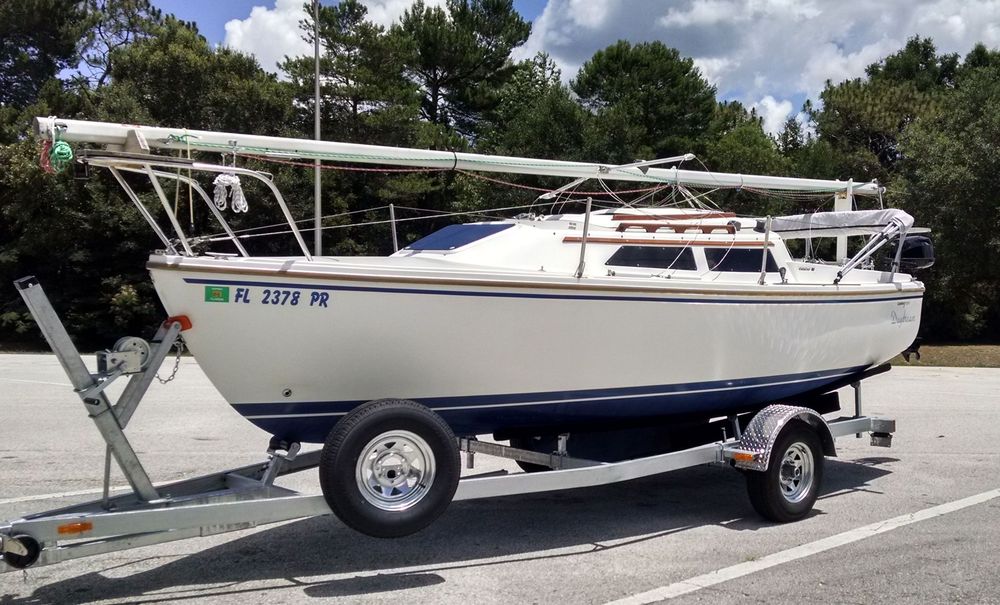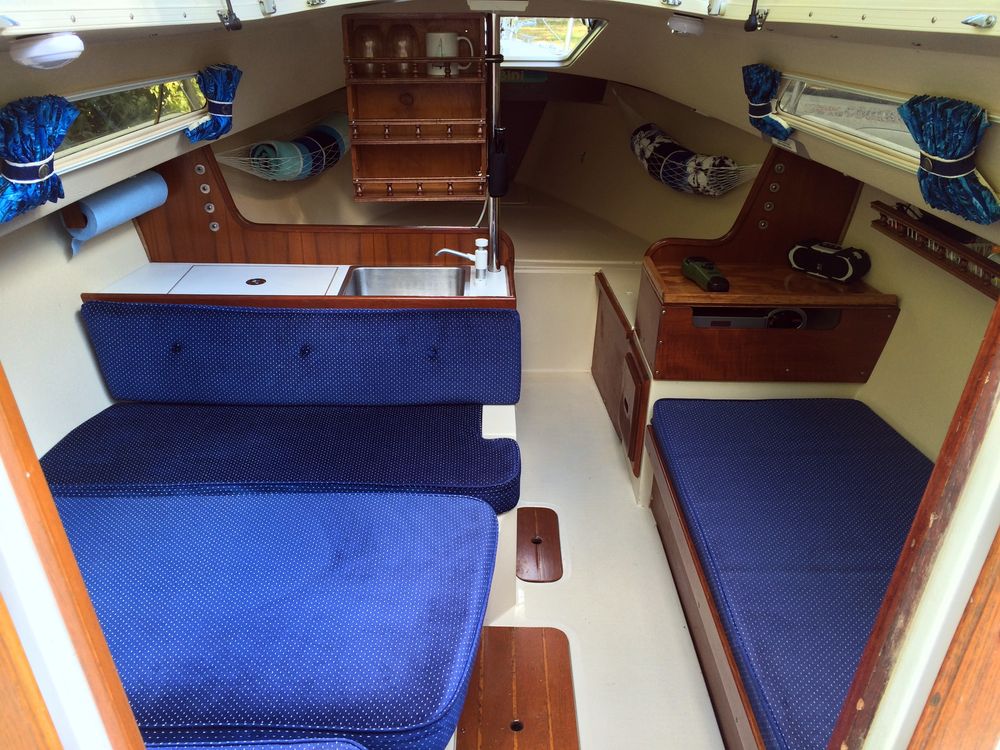Greetings from a first-time poster and novice sailor. I'll apologize up front for the length of the post and hope I'm not transgressing any forum norms.
A bit of background is probably worthwhile. My wife retired a while back and I joined her this past May, so we now have time for some leisure activities. I’ve always wanted to sail and to that end, started crewing at a local sailing club where I also recently got my ASA Basic Keelboat cert. I’ve been bitten hard by the sailing bug and want to spend more time on the water. I also want to bring both my wife and our sole remaining home companion (a young Welsh Springer Spaniel) along. With travel is also on the cards, it seems logical to combine things, bringing me to the consideration of a trailerable cruiser.
I anticipate very mixed sailing use. As noted, we are recent retirees, so have a great deal of flexibility regarding time. My location (near Philadelphia) affords easy access to a number of excellent sailing opportunities. We’re only a few miles from the Delaware River, and 30 miles from Delaware City on the Bay. The Chesapeake is not much further, and two of the Great Lakes (Erie and Ontario) are both less then 400 miles away. I’d love to get to the Florida during the cold weather months; my brother winters near Sarasota, so we have land quarters available. Both my wife and I dive, so time in the Keys may also be on the cards. Long Island Sound and New England waters are also in range.
I’ve done some of the background research via books (Annapolis Book of Seamanship, Frugal Yachting and Trailer Sailing) as well as online and have developed a very preliminary list of candidates. I plan to see as many as possible in person. As to criteria, I’m looking for something that two can comfortably sleep in for a few days and has room enough for a medium sized dog or (possibly) two. As noted, I’m a novice sailor and my wife has not really sailed at all, so I’ll also be learning on this boat. As also noted, the boat will be used in a variety of situations. To allow for that, I think she needs to be good at gunkholing and should have at least limited coastal cruising capability (when my proficiency improves to allow such.) The ability to rig the boat solo is also important, as is the ease of launch and recovery. Regarding trailerability, though the tow car has a nominal 5,000 lb capacity, I think I’d like to aim for under 3,500 lbs (w/trailer). Ideally, I’d like to get a boat from a manufacturer that’s still around to allow easier access to any needed proprietary parts.
I’m not entirely sure what to budget. A new boat is out of the question and even though I’m pretty handy, I already have a more than a few ongoing home renovation projects and do not want to add a boat restoration to the list. I’m not sure how much I’d need to spend to get a boat (wlth trailer and o/b) that needs minimal extra work to get on the water. This is one of the questions I hope those on this forum can help with.
As to in-person viewing, I was at the Chesapeake Bay Maritime Museum auction this weekend and saw a few boats firsthand, one of which is on my preliminary list, a ’95 Rhodes 22. While the boat seemed in reasonably good shape, I was not prepared to bid. I think she went for just over $1,000, with a trailer (that seemed in questionable shape) but sans sails, rigging and outboard I’ll be at the Annapolis boat show next month and will have the opportunity to not only see a variety of boats from various builders but will also have the chance to demo sail a Rhodes 22.
The Rhodes is obviously on my preliminary list; here are some others:
Catalina 22
Com Pac Eclipse
Seaward 25
WW Potter 19 (apparently no longer in production but has a very large existing base)
Any and all advice and suggestions gratefully accepted.
Charlie
A bit of background is probably worthwhile. My wife retired a while back and I joined her this past May, so we now have time for some leisure activities. I’ve always wanted to sail and to that end, started crewing at a local sailing club where I also recently got my ASA Basic Keelboat cert. I’ve been bitten hard by the sailing bug and want to spend more time on the water. I also want to bring both my wife and our sole remaining home companion (a young Welsh Springer Spaniel) along. With travel is also on the cards, it seems logical to combine things, bringing me to the consideration of a trailerable cruiser.
I anticipate very mixed sailing use. As noted, we are recent retirees, so have a great deal of flexibility regarding time. My location (near Philadelphia) affords easy access to a number of excellent sailing opportunities. We’re only a few miles from the Delaware River, and 30 miles from Delaware City on the Bay. The Chesapeake is not much further, and two of the Great Lakes (Erie and Ontario) are both less then 400 miles away. I’d love to get to the Florida during the cold weather months; my brother winters near Sarasota, so we have land quarters available. Both my wife and I dive, so time in the Keys may also be on the cards. Long Island Sound and New England waters are also in range.
I’ve done some of the background research via books (Annapolis Book of Seamanship, Frugal Yachting and Trailer Sailing) as well as online and have developed a very preliminary list of candidates. I plan to see as many as possible in person. As to criteria, I’m looking for something that two can comfortably sleep in for a few days and has room enough for a medium sized dog or (possibly) two. As noted, I’m a novice sailor and my wife has not really sailed at all, so I’ll also be learning on this boat. As also noted, the boat will be used in a variety of situations. To allow for that, I think she needs to be good at gunkholing and should have at least limited coastal cruising capability (when my proficiency improves to allow such.) The ability to rig the boat solo is also important, as is the ease of launch and recovery. Regarding trailerability, though the tow car has a nominal 5,000 lb capacity, I think I’d like to aim for under 3,500 lbs (w/trailer). Ideally, I’d like to get a boat from a manufacturer that’s still around to allow easier access to any needed proprietary parts.
I’m not entirely sure what to budget. A new boat is out of the question and even though I’m pretty handy, I already have a more than a few ongoing home renovation projects and do not want to add a boat restoration to the list. I’m not sure how much I’d need to spend to get a boat (wlth trailer and o/b) that needs minimal extra work to get on the water. This is one of the questions I hope those on this forum can help with.
As to in-person viewing, I was at the Chesapeake Bay Maritime Museum auction this weekend and saw a few boats firsthand, one of which is on my preliminary list, a ’95 Rhodes 22. While the boat seemed in reasonably good shape, I was not prepared to bid. I think she went for just over $1,000, with a trailer (that seemed in questionable shape) but sans sails, rigging and outboard I’ll be at the Annapolis boat show next month and will have the opportunity to not only see a variety of boats from various builders but will also have the chance to demo sail a Rhodes 22.
The Rhodes is obviously on my preliminary list; here are some others:
Catalina 22
Com Pac Eclipse
Seaward 25
WW Potter 19 (apparently no longer in production but has a very large existing base)
Any and all advice and suggestions gratefully accepted.
Charlie
Last edited:


